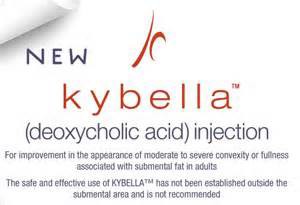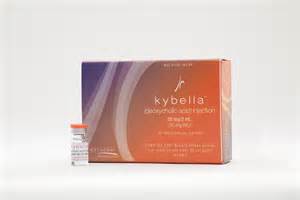The non-surgical treatment of fat has historically been difficult as external devices have a limited ability to reduce its thickness. This is particularly true in the ‘double chin’ deformity where excessive (under the chin) fat creates another roll of tissue like an extra chin. Liposuction of the submental/neck area is the gold standard by which the double chin problem is treated. (sometimes it is also helpful to do chin augmentation as well)

Kybella is deoxycholic acid which is a child sprung from its parent, Lipodissolve. Over a decade ago Lipodissolve, a mixture of deoxycholic acid and phosphatidycholine, was a national sensation as a fat dissolving injection treatment. Having its origins in Europe and South America, it was brought to the U.S. with much fanfare. Lipodissolve clinics opened up across the country providing such treatments until the FDA stepped in and ceased their operations as providing an untested and unregulated drug therapy. It was always suspected that the active agent in this mixture was the deoxycholic acid and not the phosphatidycholine. Kybella is the fully studied drug that proves this is true.
But the Lipodissolve experience can predict completely what one can expect for Kybella injections in the neck and how to compare it to liposuction surgery. This is just old history repeating itself. Kybella works by causing an inflammatory reaction that breaks down fat cell walls, allowing the release of their lipid content which is then absorbed. This will result in a predictable an profound amount of neck swelling. One essentially will look like a ‘bullfrog’ with the swelling. There is also a rather profound burning sensation that occurs in the first 30 to 60 minutes after the injections (the neck will feel really hot) but this subsides within a few hours. Thus one can expect some significant downtime with the swelling which will take one to two weeks to completely go away. While Kybella injections are non-surgical, patients should be aware that they should not have this treatment within a couple weeks of any major event.

When comparing Kybella to submental liposuction, there are some significant differences. Submental liposuction, if done alone, can be performed under local anesthesia with oral or IV sedation. It is more commonly done as part of other facial and body procedures in my practice which is then done under general anesthesia. But for the purposes of this discussion it shall be talked about as if it was done as a solitary procedure.
Submental liposuction certainly causes some swelling and bruising which can take up to six weeks to completely go away. (although the worst swelling is in the first seven to ten days) Liposuction in the neck is usually a one-time procedure although about 10% of patients may need a touch-up due to any residual remaining fat or asymmetry. (which can be done by Kybella injections if desired) The swelling after Kybella injections is usually much more than with liposuction. It is certainly far greater when one multiples it by the number of repeat Kybella injections that will be needed.
So how does one choose between Kybella injections or liposuction of the neck? In summary, liposuction produces a better result with less recovery but costs more and is an invasive procedure. Conversely, Kybella is non-surgical and costs less but has more recovery (repeated swelling) and produces less of a result. Every patient has to weigh their advantages and disadvantages and make the best decision for their own situation.
Dr. Barry Eppley
Indianapolis, Indiana


